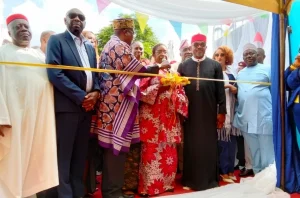Nigeria’s subnational debt landscape underwent a dramatic shift in 2024, as the total debt stock of the 36 states fell by a substantial 32.32%, dropping from ₦5.86 trillion in 2023 to ₦3.97 trillion in 2024, according to fresh data from the Debt Management Office (DMO).
This steep decline highlights a new wave of fiscal discipline, strategic debt restructuring, and increased reliance on internally generated revenue (IGR) and public-private partnerships (PPPs).
However, despite the collective contraction, some states remain heavily indebted—either due to legacy liabilities or ambitious infrastructure-driven agendas. Here are the 10 most indebted Nigerian states as of December 2024, based on official data and year-on-year comparisons.
🏛 Top 10 Most Indebted Nigerian States in 2024
1. Lagos – ₦900.19 billion
Nigeria’s economic powerhouse retained its position as the most indebted state, though it reduced its liabilities by 14.16% from ₦1.05 trillion in 2023.
Backed by an annual IGR exceeding ₦500 billion, Lagos continues to drive megaprojects while adopting PPPs and concession-based financing to limit direct borrowing.
2. Rivers – ₦364.39 billion
Rivers recorded the highest debt increase of the year—up 56.67% from ₦232.58 billion—largely due to capital expansion and post-election project execution.
Despite boasting an IGR-to-operating-expense ratio of 121%, analysts warn of repayment risks if economic returns lag.
#RiversState #CapitalProjects #DebtWatch
3. Ogun – ₦211.86 billion
Ogun slashed its debt by nearly 24%, driven by rising IGR (₦240 billion projection) and refinancing of high-interest legacy loans.
Its focus on digital revenue systems and economic diversification continues to yield fiscal benefits.
#OgunState #RevenueGrowth #DebtReduction
4. Delta – ₦199.58 billion
Delta saw a remarkable 46.55% debt drop, one of the largest in Nigeria.
The reduction was fueled by over ₦130 billion in repayments and a strategic pivot to project-tied concessional loans.
5. Bauchi – ₦143.95 billion
With a 10.48% drop, Bauchi’s “Budget of Consolidation” focused on completing existing projects and leveraging federal grants instead of new loans.
Stringent legislative scrutiny of spending also helped curb unnecessary borrowing.
6. Niger – ₦140.74 billion
Niger’s debt grew by just 0.67%, maintaining stability as the state tapped previously approved facilities for ongoing infrastructure works.
Its debt strategy favors low-interest concessional loans over commercial borrowing.
7. Imo – ₦126.14 billion
Imo achieved a dramatic 41.90% reduction, largely through revenue reforms, digital tax systems, and restructured loans.
IGR rose from ₦400 million in 2020 to nearly ₦4 billion in 2025, drastically reducing its borrowing needs.
8. Benue – ₦122.57 billion
Benue slashed its debt by 34.51%, a result of improved fiscal prudence and alignment with national debt sustainability goals.
The state also embraced expenditure control and IGR growth to limit loan dependency.
9. Akwa Ibom – ₦122.19 billion
A sharp 35.85% drop in debt reflects Akwa Ibom’s use of increased oil revenue from the 13% derivation fund and tight budget controls.
The state continues to prioritize repayment over expansion.
10. Enugu – ₦119.28 billion
Enugu stands out as one of the few states with a 29.36% increase in debt, spurred by its bold ₦521.5 billion budget, targeting massive infrastructure investments.
While the state hopes to spark “Disruptive Economic Growth,” experts urge caution over sustainability and transparency.
📊 State-Level Debt Summary: A Nation Restructuring
In total, Nigeria’s 36 states cut their domestic debt stock by over ₦1.89 trillion, the steepest annual drop in years. Key factors behind this decline include:
-
Tighter fiscal discipline and debt repayment strategies
-
A shift from high-interest loans to project-linked concessional funding
-
Greater use of PPP models and donor financing
-
Naira depreciation discouraging foreign currency-denominated debt
⚠️ Key Takeaways for Policymakers & Investors
-
Seven of the top 10 most indebted states reduced debt—a strong signal of responsible fiscal governance.
-
Lagos, Ogun, and Delta are leading examples of strategic borrowing linked to economic performance.
-
Rivers and Enugu, though fiscally strong, face questions about long-term debt sustainability.
-
For investors and lenders, tracking state debt profiles is critical to assessing Nigeria’s subnational creditworthiness.
🧠 What This Means for Nigeria
As the country grapples with macroeconomic reforms, debt management at the state level will remain a barometer for fiscal health. The trend toward sustainable borrowing, strategic planning, and revenue generation must continue for Nigeria’s economic stability and inclusive growth.


















+ There are no comments
Add yours